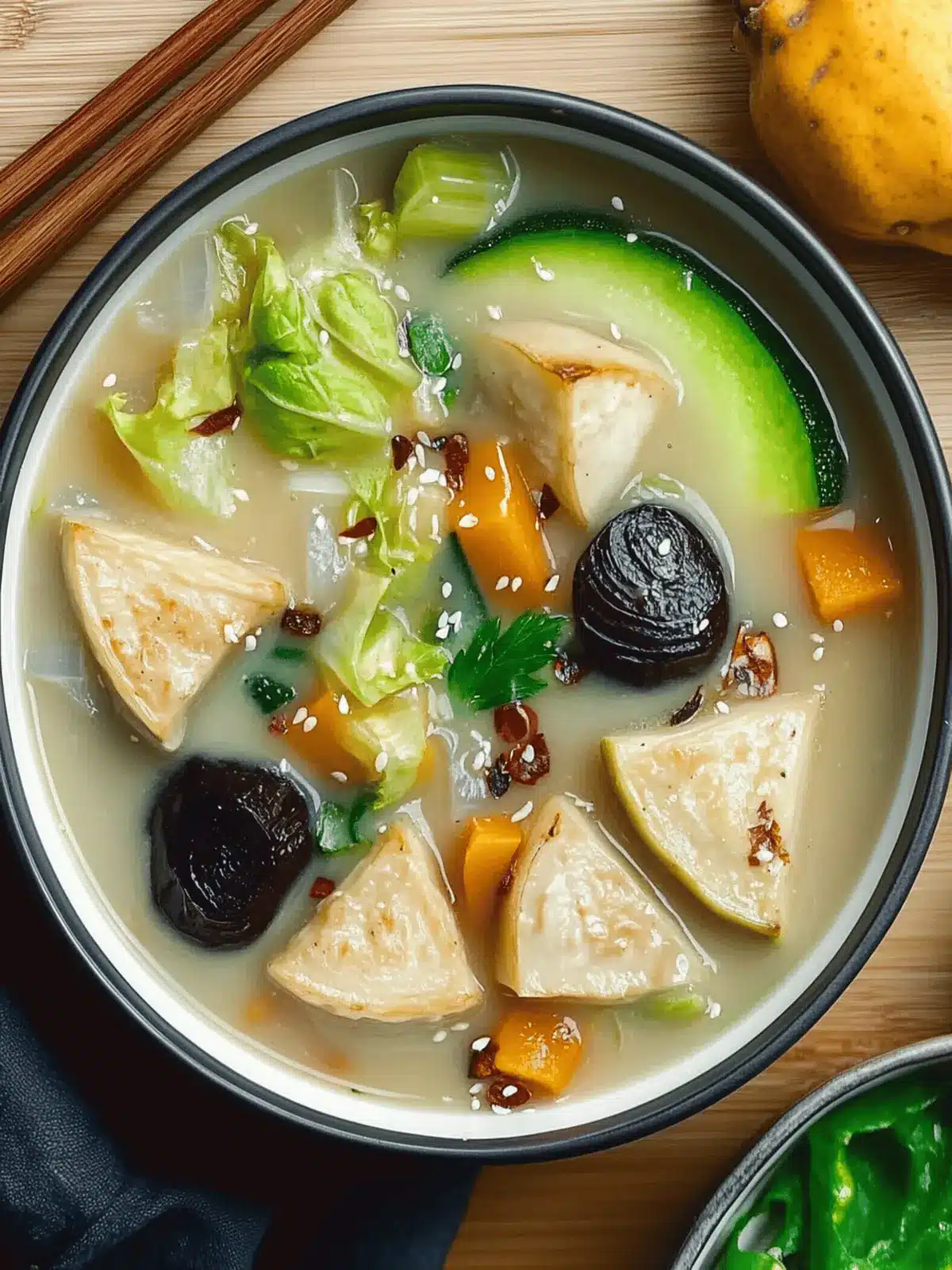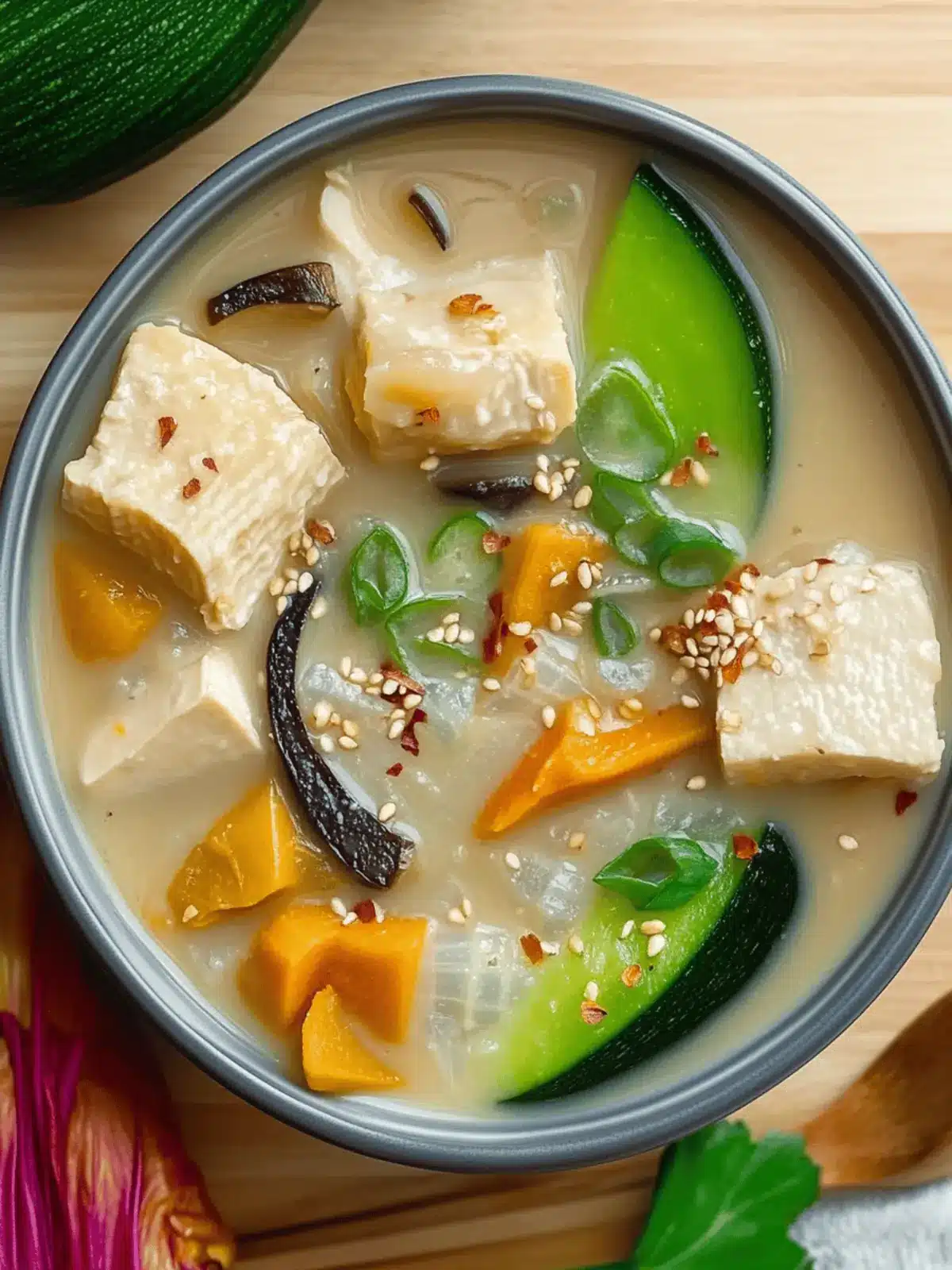After a long day of juggling responsibilities, there are few things more comforting than a warm bowl of stew. As the first signs of winter settle in, I find myself craving something hearty and nourishing, and that’s precisely when my creamy miso stew comes to life. Imagine the rich aroma of garlic and ginger mingling with earthy kabocha squash and savory shiitake mushrooms, creating a cozy embrace for both body and soul.
This isn’t just any stew; it’s a delightful twist on traditional Japanese flavors, designed to bring joy—not just to your taste buds but to your entire cooking experience. Perfect for a cozy dinner or a satisfying lunch, the creamy miso base, along with tender dumplings and a medley of fresh vegetables, makes this dish unique and versatile. Whether you’re an experienced chef or just looking to break free from the fast-food routine, this Vegetable Miso Stew will surely become a favorite in your kitchen. Let’s dive into this bowl of warmth and flavor!
Why is Vegetable Miso Stew so comforting?
Comforting and Hearty: This Vegetable Miso Stew warms you from the inside out, making it the ultimate comfort food for chilly evenings.
Umami Explosion: Packed with umami-rich miso, every spoonful bursts with depth and richness.
Easy to Prepare: With simple steps and readily available ingredients, even beginner cooks can whip this up effortlessly.
Versatile: Customize with whatever vegetables you have on hand and enjoy endless variations, ensuring no two bowls are the same.
Nutritional Powerhouse: Rich in fiber and probiotics, this stew isn’t just delicious—it’s good for your gut health too! Check out our tips on how to integrate more veggies for a fantastic boost.
Vegetable Miso Stew Ingredients
For the Stew
- Olive Oil – Adds richness and helps sauté vegetables; any neutral oil can be a good substitute.
- Onion – Provides aromatic sweetness; feel free to use yellow, white, or red onions.
- Garlic – Enhances flavor; fresh cloves are always best for the keenest taste.
- Ginger – Introduces a warm, zesty aroma; fresh ginger provides the most effective punch.
- White Miso – Essential for the umami backbone of the stew; for a bolder flavor, you can swap it for red miso.
- Unsweetened Almond Milk – Acts as the creamy base; consider using any favorite non-dairy milk instead.
- Vegetable Broth – Infuses savory notes; choose low-sodium versions to control salt intake.
- Kabocha Squash – Adds natural sweetness and velvety texture; butternut squash can be a tasty alternative.
- Firm Tofu – Provides protein and heartiness; silken tofu can be used for a creamier texture.
- Shiitake Mushrooms – Contributes an earthy flavor; feel free to substitute with any mushrooms you have on hand.
- Savoy Cabbage – Offers crunch and nutrition; regular green cabbage works well if needed.
- Frozen Soup Dumplings – Enhance texture contrast; store-bought varieties are convenient and time-saving.
- Mirin – Sweet rice wine that deepens flavor; if unavailable, mix a bit of sugar with water as a substitute.
- Tamari/Soy Sauce – Balances the flavors; use low-sodium options for a lighter taste.
- Chili Oil – Adds a desired spicy kick as a garnish, if desired.
- Chopped Green Onions – Brightens the dish with a fresh finish.
- Toasted Sesame Seeds – Optional but adds a delightful crunch and nutty essence.
- Pomegranate Arils – Optional for a sweet burst and beautiful presentation, adding contrast.
This Vegetable Miso Stew is not only comforting but allows you to play with fresh, seasonal ingredients, making it a staple for any cozy meal!
How to Make Vegetable Miso Stew
-
Warm the Oil: In a soup pot, heat the olive oil over medium heat, allowing it to shimmer but not smoke. This will set the stage for sautéing your aromatics.
-
Sauté Aromatics: Add the chopped onion, garlic, and ginger. Cook for 1-2 minutes until fragrant and the onion is translucent, filling your kitchen with warm, inviting aromas.
-
Combine the Base: Pour in the almond milk, vegetable broth, soy sauce, mirin, and add sliced kabocha squash. Cook for 5-7 minutes, stirring occasionally, until the squash is tender yet retains its shape.
-
Add the Heartiness: Introduce sliced shiitake mushrooms, diced tofu, and frozen dumplings to the pot. Let it simmer until the dumplings are fully cooked, about 6-8 minutes, stirring gently to prevent sticking.
-
Incorporate Greens: Add the sliced savoy cabbage, stirring until it wilts down, which should take about 2-3 minutes, enhancing the texture and nutritional content of your stew.
-
Miso Magic: In a ladle, dissolve the miso with a small amount of hot broth, then stir it back into the pot. Remove from heat immediately to preserve the probiotics in the miso.
-
Serve Delightfully: Ladle the stew into bowls, making sure to provide an even distribution of delicious ingredients. Garnish it with chili oil, sesame seeds, fresh green onions, and pomegranate arils if you’re using them.
Optional: Drizzle with a touch more chili oil for an extra kick.
Exact quantities are listed in the recipe card below.
Expert Tips for Vegetable Miso Stew
-
Dissolve Miso Properly: Always dissolve the miso in a ladle with broth before adding it to avoid clumping, ensuring a smooth texture in your vegetable miso stew.
-
Avoid Boiling: After adding the miso, don’t boil the stew. This preserves the beneficial probiotics and the stew’s rich flavor.
-
Choose the Right Dumplings: When using frozen dumplings, ensure they’re fully heated through but avoid overcooking, which can lead to a mushy texture in your stew.
-
Customize Veggies: Feel free to mix and match your favorite veggies based on what’s in season or in your pantry, making each vegetable miso stew uniquely yours.
-
Enhance Creaminess: Experiment with different plant-based milks to adjust the creaminess, and don’t hesitate to add more almond milk if you prefer a silkier broth.
Make Ahead Options
These Creamy Vegetable Miso Stew ingredients are perfect for meal prep, allowing you to enjoy a hearty bowl with minimal effort on busy weeknights! You can chop the vegetables, tofu, and mushrooms up to 24 hours in advance, storing them in an airtight container in the refrigerator. Additionally, you can create the stew base (excluding the miso and dumplings) and refrigerate it for up to 3 days. To maintain the quality, avoid adding the miso until you’re ready to serve, and simply reheat the stew base on the stovetop, then stir in the miso and frozen dumplings before serving. You’ll have a delicious meal that’s just as comforting as when you first made it!
What to Serve with Creamy Vegetable Miso Stew?
Enhance your comforting bowl of creamy vegetable miso stew with delightful accompaniments that accentuate its flavors and textures.
- Crusty Bread: This warm, hearty bread is perfect for dipping into the stew, soaking up that rich broth for a wonderful experience.
- Fresh Side Salad: A light, vibrant salad with a citrus vinaigrette adds a refreshing crunch, balancing the warmth of the stew beautifully.
- Steamed Rice: Serve fluffy rice on the side for an extra filling option, adding a wholesome base to absorb the savory miso flavors.
- Sesame Noodles: A plate of cold sesame noodles provides a comforting yet playful contrast, adding an Asian flair to your meal.
Pairing a warm, fluffy loaf with the creamy vegetable miso stew captures the essence of home, wrapping everything in delicious memories. Dessert could also be a great addition! Perhaps a light fruit sorbet would cleanse the palate delightfully after such a satisfying meal.
Vegetable Miso Stew Variations
Feel free to make this cozy dish your own with these exciting twists and substitutions!
- Dairy-Free Creaminess: Use coconut milk instead of almond milk for a richer, tropical flavor that enhances the stew’s creaminess.
- Protein Boost: Add chickpeas or lentils for an extra protein kick; they blend beautifully with the stew’s flavors.
- Spicy Kick: Incorporate fresh chili peppers or sriracha to amp up the heat levels and create a more vibrant dish.
- Different Squash: Swap kabocha for butternut or acorn squash to explore new sweetness and textures, making the dish even more delightful.
- Mixed Mushrooms: Experiment by using a blend of shiitake, oyster, and button mushrooms to create a more complex and layered umami experience.
- Herb Infusion: Add fresh herbs like cilantro or basil right before serving to introduce an aromatic freshness that brightens the entire stew.
- Nutty Crunch: Top the stew with crushed peanuts or hazelnuts for a crunchy contrast that adds an exciting texture to every spoonful.
- Sweet Pop: Toss in some baby spinach or kale towards the end of cooking for a nutritious boost that adds color and vibrancy to your bowl.
Enjoy exploring these variations, and let each bowl reflect your personal taste!
Storage Tips for Vegetable Miso Stew
- Fridge: Store leftover vegetable miso stew in an airtight container for up to 3 days; keep it tucked in a cool part of your refrigerator to maintain freshness.
- Freezer: For longer storage, freeze the stew in portioned airtight containers or freezer bags for up to 2 months, ensuring to leave some space for expansion.
- Reheating: Reheat gently on the stovetop over low heat, adding a splash of broth or almond milk for the desired consistency, and stir frequently to avoid sticking.
- Thawing: When ready to enjoy, thaw frozen stew overnight in the fridge or use the microwave’s defrost setting before reheating to restore that creamy texture.
Vegetable Miso Stew Recipe FAQs
What’s the best way to select kabocha squash?
Choose a kabocha squash that feels heavy for its size and has a firm skin without any dark spots or soft blemishes. The color should be a deep green or even slightly yellowish. If it seems watery when you shake it, that’s a sign it may be overripe.
How should I store leftover Vegetable Miso Stew?
Store any leftover stew in an airtight container in your refrigerator for up to 3 days. Be sure to keep it in the coolest part of your fridge to ensure it stays fresh. When reheating, add a splash of broth or almond milk for consistency.
Can I freeze Vegetable Miso Stew?
Absolutely! To freeze your vegetable miso stew, let it cool completely, then divide it into portioned airtight containers or freezer bags, leaving space for expansion. It can be frozen for up to 2 months. To reheat, thaw overnight in the fridge and gently warm on the stovetop, adding liquid as necessary to achieve your desired thickness.
What should I do if my stew is too salty?
If your stew turns out saltier than expected, you can balance the flavors by adding a little more almond milk or a splash of water to dilute the saltiness. You can also throw in some extra vegetables to soak up the excess salt, adjusting the flavor while enhancing the stew’s volume.
Are there any dietary considerations for this Vegetable Miso Stew?
Yes! This stew is vegan and dairy-free, making it suitable for plant-based diets. However, if you’re preparing it for someone with soy allergies, consider substituting the tofu with chickpeas or another bean for protein. Always check labels on broth and dumplings to ensure they’re free from gluten if that’s a concern.
How can I enhance the creaminess of my Vegetable Miso Stew?
For a creamier texture, try using a full-fat canned coconut milk or adding an extra splash of almond milk while cooking. If you want even more richness, blend part of the stew with an immersion blender before adding any delicate ingredients. This technique will provide a velvety base while still maintaining chunks of hearty vegetables and dumplings.

Creamy Vegetable Miso Stew: Cozy Up with Comfort Food
Ingredients
Equipment
Method
- Warm the Oil: In a soup pot, heat the olive oil over medium heat.
- Sauté Aromatics: Add the chopped onion, garlic, and ginger. Cook until fragrant and the onion is translucent.
- Combine the Base: Pour in almond milk, vegetable broth, soy sauce, mirin, and add sliced kabocha squash. Cook until the squash is tender.
- Add the Heartiness: Introduce sliced shiitake mushrooms, diced tofu, and frozen dumplings. Let it simmer until the dumplings are cooked.
- Incorporate Greens: Add the sliced savoy cabbage, stirring until it wilts.
- Miso Magic: In a ladle, dissolve the miso with a small amount of hot broth, then stir it back into the pot.
- Serve Delightfully: Ladle the stew into bowls and garnish with chili oil, sesame seeds, fresh green onions, and pomegranate arils if using.








